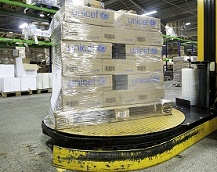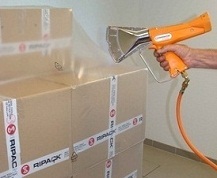Stretch Wrapping vs. Shrink Wrapping - Understanding The Difference
When it comes to protecting products, or holding products together and intact for transport; stretch and shrink wrapping are often employed. Although these two types of wrapping have many differences, they are often confused. This blog aims to outline the differences between the two products and under what application they are both utilized.
| Stretch wrapping | Shrink wrapping |
|---|---|
 Stretch wrapping is stretchable plastic film that is wrapped around a load of products allowing it to be stretched; this elasticity holds the load tightly together. |
 Shrink Wrapping is covered loosely around a product or load & it shrinks tightly when heat is applied. |
What is it made from?Most commonly made from polyethylene plastics. What is it used for?This type of wrapping is usually employed to hold loads and products together on a pallet for transportation or storage purposes. Stretch wrap can come in a variety of specialty films. Some examples are: UV stretch wrap, vented pallet wrap, anti-static stretch film, colored stretch film, pre-stretched stretch film, etc. What are the advantages?Protective – This wrapping is secure and protects products from dust and moisture. It can also protect from sun with UV film options Cost Effective – Stretch wrap is less expensive than other types of pallet wrapping. Additionally the equipment needed for stretch wrapping is cheaper than other forms of wrapping. Adaptable – Stretch wrap has a variety of films to suit each application; and it is even appropriate for different types of surfaces. Available EquipmentManual wrappers include the extended core with a film extension used as a handle. Mechanical brakes have a supporting structure with a break resistance system. Pole wrappers involve an extended pole for easier use. Stretch wrap machines are suggested when wrapping more than 15 loads per day. Stretch wrap machines help to reduce waste and to increase efficiency. Semi-automatic machines include turntable wrappers where the load is placed on a turntable and wrapped by film which moves vertically. Rotary arm wrappers rotate around a still load to wrap. Orbital wrappers involve feeding the load though a rotating ring of film. Automatic wrappers involve conveyer belts and automatic machines to cut and seal the stretch wrap.
|
What is it made from?Most commonly made from polyolefin plastics. What is it used for?This type of wrapping is usually employed to protect a single product from dust or weather; or to tightly combine smaller items together. It can also wrap products together on a pallet; but is less common. This wrapping is widely used for covering foods; for example, cheese, meats and vegetables. What are the advantages?Protective – Shrink wrap is great for protecting products from weather or moisture damage along with dust and dirt. No surface damage – If shrink wrapping has been properly applied you should have no issues with chafing or damage during transportation or whilst being stored. Breathability- Shrink wrap has the option of being ventilated; therefore reducing any damage that can occur from moisture. Available EquipmentA heating machine is essential when using any type of shrink wrap. Some of the shrink wrap machines available for heating are; heat guns which release a stream of hot air, shrink tunnels which are mounted over or around a conveyor system for the product to flow through, along with ovens. Heat guns are necessary for more professional looking shrink wrap jobs as shrink wrap properly shrinks at 300 degrees Fahrenheit. Many auto and manual shrink wrapping machines are also available such as L-Bar sealers and I-Bar Sealers.
Most shrink wrap sealing machines can cut and seal the shrink wrap together; and once this has been done it is ready for heating in order to shrink and tighten the plastic to the product. |